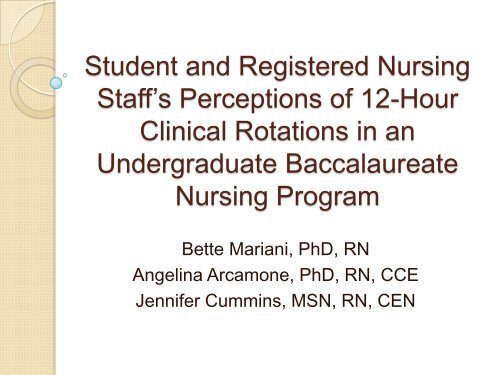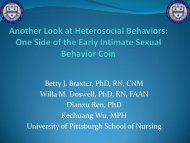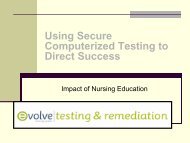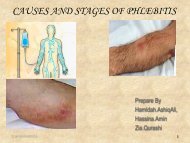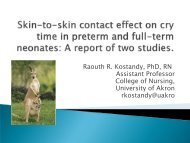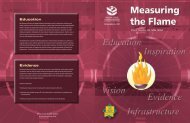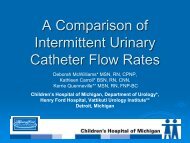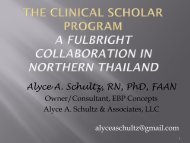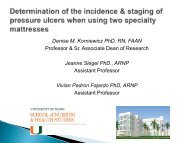Student and Registered Nursing Staff's Perceptions of 12-Hour ...
Student and Registered Nursing Staff's Perceptions of 12-Hour ...
Student and Registered Nursing Staff's Perceptions of 12-Hour ...
Create successful ePaper yourself
Turn your PDF publications into a flip-book with our unique Google optimized e-Paper software.
<strong>Student</strong> <strong>and</strong> <strong>Registered</strong> <strong>Nursing</strong><br />
Staff’s <strong>Perceptions</strong> <strong>of</strong> <strong>12</strong>-<strong>Hour</strong><br />
Clinical Rotations in an<br />
Undergraduate Baccalaureate<br />
<strong>Nursing</strong> Program<br />
Bette Mariani, PhD, RN<br />
Angelina Arcamone, PhD, RN, CCE<br />
Jennifer Cummins, MSN, RN, CEN
Background<br />
• With today’s increase in student enrollment<br />
in baccalaureate education it has become<br />
more difficult to secure quality clinical<br />
placements with optimal learning<br />
experiences <strong>and</strong> clinical faculty<br />
• Some clinical agencies are only able to <strong>of</strong>fer<br />
<strong>12</strong> hour clinical shift rotations for student<br />
experiences<br />
• There are a limited number <strong>of</strong> studies that<br />
have been conducted on the use <strong>of</strong> <strong>12</strong> hour<br />
clinical shift rotations with nursing students,<br />
with little evidence to support the use <strong>of</strong> this<br />
clinical scheduling strategy<br />
2
Purpose <strong>of</strong> Study<br />
• The purpose <strong>of</strong> this study is to evaluate the<br />
student <strong>and</strong> registered nursing staff’s<br />
perceptions <strong>of</strong> whether the <strong>12</strong>-hour clinical<br />
shift rotation enhances the student’s clinical<br />
learning ability, allows for better continuity<br />
<strong>of</strong> care for their assigned patients <strong>and</strong><br />
families, <strong>and</strong> facilitates the ability to<br />
correlate theory to nursing practice.<br />
3
Research Questions<br />
1. Do nursing students perceive that a <strong>12</strong>-<br />
hour clinical rotation is beneficial to their<br />
clinical learning<br />
2. Do nursing staff perceive that working with<br />
nursing students during a <strong>12</strong>-hour clinical<br />
experience is beneficial<br />
4
Research Questions (con’t.)<br />
3. Do nursing students feel that the <strong>12</strong>-hour<br />
clinical rotation allows for a better<br />
opportunity for continuity <strong>of</strong> care <strong>and</strong><br />
learning for their assigned patients <strong>and</strong><br />
families<br />
4. What are the advantages <strong>and</strong><br />
disadvantages <strong>of</strong> a <strong>12</strong>-hour clinical<br />
rotation perceived by nursing students <strong>and</strong><br />
staff<br />
5
Methodology<br />
• A mixed method descriptive design<br />
was used to conduct the study,<br />
incorporating both qualitative <strong>and</strong><br />
quantitative method<br />
• IRB approval obtained from Villanova<br />
University <strong>and</strong> Clinical Site Facility<br />
6
Research Instrument <strong>and</strong><br />
Method <strong>of</strong> Data Collection<br />
• Questionnaire*<br />
◦ Separate questionnaire for RNs <strong>and</strong> <strong>Student</strong>s<br />
◦ Likert Scale <strong>and</strong> Open-ended questions<br />
◦ Fall 2010 with 28 subjects<br />
• Cronbach’s Alpha <strong>Student</strong> Questionnaire = .82<br />
• Cronbach’s Alpha Nurse Questionnaire = .93<br />
◦ Spring 2011 with 38 subjects<br />
• Cronbach’s Alpha <strong>Student</strong> Questionnaire = .88<br />
• Focus groups<br />
◦ Three student focus groups held on campus<br />
◦ Four open-ended questions asked<br />
For the students questionnaires, additional data was collected in Spring<br />
2011 <strong>and</strong> was added to the original data from Fall 2010.<br />
*Questionnaire adapted with permission from Rossen, B. E. <strong>and</strong> Fegan, M. A. (2009)<br />
7
Sample Questions on <strong>Student</strong><br />
Questionnaire<br />
Using the Likert Scale, please respond to the following<br />
statements below based on your perception <strong>of</strong> the<br />
<strong>12</strong>-hour clinical shift rotation in which you participated:<br />
1. The <strong>12</strong>-hour clinical shift rotation enhanced my clinical<br />
learning experience.<br />
2. I had a better opportunity for continuity <strong>of</strong> care for my<br />
assigned patients <strong>and</strong> families when I participated in the<br />
<strong>12</strong>-hour clinical shift in comparison to the traditional 6 or 8<br />
hour clinical day.<br />
3. Participating in the <strong>12</strong>-hour clinical shift allowed me a<br />
greater opportunity to evaluate the results <strong>of</strong> my nursing<br />
interventions in comparison to the traditional 6 or 8 hour<br />
clinical day.<br />
4. I had more time to interact <strong>and</strong> discuss patient care<br />
issues with my instructor during the <strong>12</strong>-hour clinical shift<br />
in comparison to the traditional 6 or 8 hour clinical day.<br />
8
Sample Questions on Nurse<br />
Questionnaire<br />
Using the Likert Scale, please respond to the following<br />
statements below based on your perception <strong>of</strong> the<br />
<strong>12</strong>-hour clinical shift rotation in which you participated:<br />
1. The <strong>12</strong>-hour clinical shift allowed the students to develop<br />
a collaborative working relationship with the nursing staff.<br />
2. The <strong>12</strong>-hour clinical shift enhanced the students ability to<br />
correlate theoretical principles with clinical practice.<br />
3. The students had more time to interact <strong>and</strong> discuss<br />
clinical issues with the nursing staff when participating in<br />
the <strong>12</strong>-hour clinical shift in comparison to the traditional 6<br />
or 8 hour clinical day.<br />
4. The <strong>12</strong>-hour clinical shift exposed the students to a wider<br />
spectrum <strong>of</strong> clinical situations.<br />
9
Sample <strong>and</strong> Setting<br />
• Sample<br />
◦ Junior level nursing students in the traditional<br />
<strong>and</strong> second degree BSN program who were<br />
assigned to <strong>12</strong>-hour clinical rotations in an<br />
acute care setting<br />
◦ <strong>Registered</strong> nurses who worked with the<br />
students at the clinical agencies in an acute<br />
care ICU setting<br />
• Setting<br />
◦ Two acute care clinical agencies in the greater<br />
Philadelphia area<br />
◦ Focus groups were conducted on campus<br />
10
Sample Description<br />
• <strong>Student</strong>s<br />
◦ Number <strong>of</strong> students in <strong>12</strong>-hour rotations<br />
Fall 2010 = 47<br />
• 45 females, 2 male<br />
• Age range 20-41<br />
Spring 2011 = 28<br />
• 23 females, 5 males (4 international students)<br />
• Age range 20-27<br />
◦ Questionnaires<br />
• Total returned surveys N = 28 (Fall 2010 - 60% return)<br />
• Total returned surveys N = 10 (Spring 2011 - 36% return)<br />
◦ Focus group participants<br />
• Total focus groups<br />
• N = 3 groups<br />
• All females<br />
• Age 20 - 41<br />
11
Sample Description<br />
• Staff RNs<br />
◦ Number <strong>of</strong> RNs who worked with students = 15<br />
◦ Total returned questionnaires<br />
• N = 8 (53 % return)<br />
◦ Demographics<br />
• All females<br />
• Age range 48 – 59<br />
• Education level: majority had an associate or<br />
bachelor’s degree<br />
• Mean years <strong>of</strong> work experience = 29.37<br />
• Mean years in specialty = 27.62<br />
<strong>12</strong>
Statistical Analyses<br />
• Cronbach’s Alpha using SPSS<br />
• Descriptive statistics using SPSS<br />
◦ Mean<br />
◦ Range<br />
◦ St<strong>and</strong>ard deviation<br />
• Reviewed open-ended questions on<br />
questionnaires <strong>and</strong> focus group transcripts<br />
for common themes<br />
13
Findings from Questionnaire<br />
<strong>Student</strong> Responses<br />
(on Likert Scale: 5 = strongly agree, 1 = strongly disagree)<br />
Fall 2010 Spring 2011<br />
(n = 28) (n = 38)<br />
1. The <strong>12</strong> hour clinical enhanced learning……….. 4.68 4.58<br />
2. Continuity <strong>of</strong> patient care…………………….. 4.86 4.79<br />
3. Evaluate interventions……………………..……. 4.71 4.66<br />
4. Acceptance by staff………………………..…... 4.04 3.94<br />
5. Acceptance by staff facilitated learning……..… 4.43 4.39<br />
6. Enhanced collaborative relationship with staff.... 4.57 4.42<br />
7. Enhanced ability to correlate theory to practice... 4.39 4.34<br />
8. Increased time with instructor…………………..… 4.61 4.50<br />
9. Increased exposure to clinical situations……..… 4.57 4.55<br />
For the students questionnaires, additional data was collected in<br />
Spring 2011<strong>and</strong> was added to the original data from Fall 2010.<br />
14
Findings from Questionnaire<br />
Nurse Responses<br />
(on Likert Scale: 5 = strongly agree, 1 = strongly disagree)<br />
1. The <strong>12</strong> hour clinical enhanced learning………….. 4.63<br />
2. Continuity <strong>of</strong> patient care………………………..… 4.63<br />
3. Evaluate interventions……………………………... 4.63<br />
4. Acceptance by staff facilitated learning…………... 5.00<br />
5. Enhanced collaborative relationship with staff…... 4.88<br />
6. Enhanced ability to correlate theory to practice…. 4.75<br />
7. Increased time with nursing staff………………….. 4.75<br />
8. Increased exposure to clinical situations………… 4.88<br />
15
<strong>Student</strong>’s Responses Focus Groups<br />
<strong>and</strong> Open-Ended Questions<br />
Themes:<br />
• Enhanced learning<br />
◦ More observations/real life experiences/ability to apply<br />
◦ Enhanced learning from nurses, clinical faculty,<br />
physicians <strong>and</strong> respiratory<br />
◦ Mid-conference during the day<br />
◦ “Got to do med-pass several times throughout the day.”<br />
◦ Able to apply classroom knowledge during downtime<br />
◦ “More access to clinical instructor, they reviewed things<br />
that couldn’t be reviewed on shorter day”<br />
◦ Learning not fragmented, bigger picture<br />
◦ “I just loved it, I learned so much.”<br />
◦ More time to study nursing problems<br />
◦ Able to evaluate patients<br />
16
<strong>Student</strong>’s Responses Focus Groups<br />
Themes:<br />
<strong>and</strong> Open-Ended Questions<br />
• Communication<br />
◦ Rapport with patient, family, nurses <strong>and</strong> physicians<br />
enhanced<br />
◦ Increased relationship with patient<br />
◦ Better treatment from staff nurses, relationship enhanced<br />
◦ “Nurse was happy <strong>and</strong> excited I would be there all day.”<br />
◦ “Felt respected by the nursing staff because we were<br />
there longer.”<br />
◦ “Forced me to include the family in the plan <strong>of</strong> care, most<br />
families visit around 4 or 5 after their work day.”<br />
17
<strong>Student</strong>’s Responses Focus Groups<br />
Themes:<br />
<strong>and</strong> Open-Ended Questions<br />
• Collaboration<br />
◦ More opportunity to interact with interdisciplinary team<br />
◦ Better treatment from staff nurses, relationship<br />
enhanced<br />
◦ Felt part <strong>of</strong> the team<br />
◦ Got to work with one nurse for the entire day<br />
◦ “Encouraged teamwork amongst students to coordinate<br />
care <strong>and</strong> lunch breaks.”<br />
18
<strong>Student</strong>’s Responses Focus Groups<br />
<strong>and</strong> Open-Ended Questions<br />
Themes:<br />
• Continuity <strong>of</strong> Care<br />
◦ More continuity <strong>of</strong> care (stated by multiple students)<br />
◦ “…..facilitates a more fluid day”<br />
◦ Ability to do multiple assessments <strong>and</strong> documentation, able<br />
to notice differences <strong>and</strong> improvements throughout the day<br />
◦ Had more interactions with patients <strong>and</strong> families<br />
◦ Could follow the course <strong>of</strong> care <strong>of</strong> the patient for a longer<br />
amount <strong>of</strong> time<br />
◦ One <strong>of</strong> the main advantages <strong>of</strong> the <strong>12</strong>-hour shift is<br />
continuity <strong>of</strong> care…you are able to see the patient through<br />
the day.”<br />
◦ “I was able to play a role in the continuity <strong>of</strong> care <strong>of</strong> my<br />
patients.” 19
<strong>Student</strong>’s Responses Focus Groups<br />
<strong>and</strong> Open-Ended Questions<br />
Other comments:<br />
• “Able to observe, then do.”<br />
• “Realistic view <strong>of</strong> nursing.”<br />
• “All students should participate in one.”<br />
• Could see the results <strong>of</strong> our interventions<br />
• “I actually think having the <strong>12</strong>-hour shift is an<br />
asset to the program <strong>and</strong> will help make more<br />
thorough <strong>and</strong> prepared students.”<br />
• “I feel we had an advantage over those who<br />
did not have <strong>12</strong>-hour clinical shifts.”<br />
• Got to know the patient behind the disease<br />
20
<strong>Student</strong>’s Responses Focus Groups<br />
Theme:<br />
• Disadvantages<br />
◦ Tired at the end <strong>of</strong> the shift<br />
◦ “Long day for a college student.”<br />
◦ “If paired with a nurse who was not pleasant, then it made<br />
for a long day.”<br />
◦ “Really hard to find a disadvantage, I wish we had more<br />
days on the unit, because I loved it so much.”<br />
◦ Too much time in between clinical days<br />
◦ No down-time on clinical days<br />
◦ If slow day or clinical was cancelled (snow days) it’s like<br />
missing two days<br />
◦ Time went fast, ↓ in days was hard, because it limited time<br />
on unit<br />
21
RNs Responses Open-Ended<br />
Themes:<br />
Questions<br />
• Enhanced time for teaching<br />
◦ Not rushed<br />
◦ See students strengths <strong>and</strong> weaknesses<br />
◦ More experience/exposure/more time to teach<br />
student<br />
◦ Time management skills can be developed<br />
◦ Able to interact with students <strong>and</strong> more time to<br />
formulate plan <strong>of</strong> care<br />
22
RNs Responses Open-Ended<br />
Themes:<br />
• Continuity <strong>of</strong> care<br />
Questions<br />
o Can see consequences <strong>of</strong> treatments <strong>and</strong><br />
interventions<br />
o Continuity <strong>of</strong> care<br />
• Other comments:<br />
o Exposure to a more realistic working situation<br />
23
Theme:<br />
RNs Responses Open-Ended<br />
• Disadvantages<br />
◦ Fatigue<br />
Questions<br />
◦ “Primary nurse can get tired, it’s a long time to talk<br />
through your day.”<br />
◦ Sometimes hard to keep up with work while also<br />
working with students, i. e. charting<br />
◦ No disadvantages<br />
◦ Sometimes depends on patient acuity, if not good,<br />
then experiences can vary<br />
24
Discussion <strong>of</strong> Findings<br />
• There were similar themes found between the students<br />
<strong>and</strong> nurses related to continuity <strong>of</strong> care<br />
• <strong>Student</strong> responses supported the theme <strong>of</strong> enhanced<br />
learning, while nurse responses supported the theme <strong>of</strong><br />
enhanced time for teaching<br />
• For Fall 2010 the highest mean on the student<br />
questionnaire was 4.86 on the question related to<br />
continuity <strong>of</strong> care (with the added data from Spring 2011,<br />
this was still the highest mean at 4.79)<br />
• For Fall 2010, the lowest score on the student<br />
questionnaire was 4.04 for the question related to staff<br />
acceptance (with the additional data from Spring 2011 this<br />
was still the lowest mean score at 3.94)<br />
• Overall, the response from students <strong>and</strong> nurses was<br />
positive regarding <strong>12</strong>-hour clinical shifts for student<br />
rotations<br />
25
• Education<br />
Implications for <strong>Nursing</strong><br />
◦ Provides support for alternate clinical learning experience<br />
◦ Enables greater opportunity for creative teaching-learning<br />
strategies between students, nurses, <strong>and</strong> faculty in the<br />
clinical setting<br />
• Practice<br />
◦ Provides students with a more realistic practice<br />
environment<br />
◦ Opportunity for enhanced collaborative relationships<br />
between healthcare team <strong>and</strong> students<br />
• Research<br />
◦ Replication <strong>of</strong> the study for more generalizability <strong>of</strong> results<br />
26
Limitations<br />
• Small sample size<br />
◦ Have added to original sample<br />
• Single site study<br />
• No content validity on the research<br />
questionnaires<br />
• Unable to conduct staff nurse focus<br />
groups, due to scheduling<br />
27
• Thank you to the nursing students<br />
<strong>and</strong> staff nurses for their<br />
participation in the study.<br />
• Thank you, also, to Jaclyn<br />
Parkinson, graduate student <strong>and</strong><br />
assistant for her help with the<br />
focus groups.<br />
28
Reference List<br />
• Heaslip, J. (1988). <strong>Student</strong> reaction to the <strong>12</strong>-hour<br />
shift in an undergraduate baccalaureate nursing<br />
program. Journal <strong>of</strong> <strong>Nursing</strong> Education, 27 (1), 19-<br />
22.<br />
• Reid, N., Robinson, G., <strong>and</strong> Todd, C. (1994). The <strong>12</strong>-<br />
hour shift: The views <strong>of</strong> nurse educators <strong>and</strong><br />
students. Journal <strong>of</strong> Advanced <strong>Nursing</strong>, 19, 938-<br />
946.<br />
• Rossen, B. E. <strong>and</strong> Fegan, M. A. (2009). Eight or<br />
twelve-hour shifts: What nursing students prefer.<br />
<strong>Nursing</strong> Education Perspectives, 30 (1), 40-43.<br />
• Tobar, K., Wall, D., Parsh, B., <strong>and</strong> Sampson, J. (2007).<br />
Use <strong>of</strong> <strong>12</strong>-hour clinical shifts in nursing education:<br />
Faculty, staff, <strong>and</strong> student response. Nurse Educator,<br />
32 (5), 190-191.<br />
29


